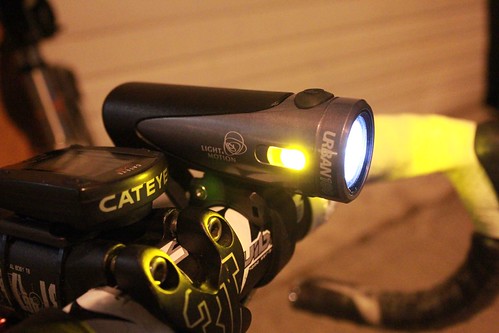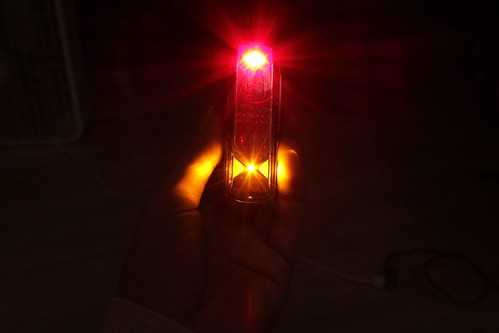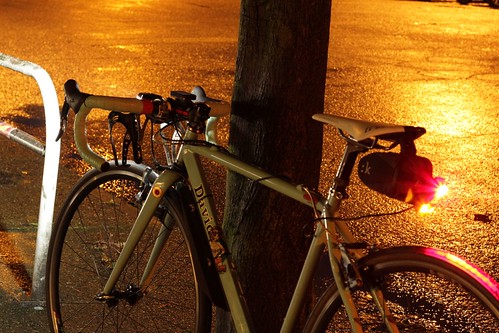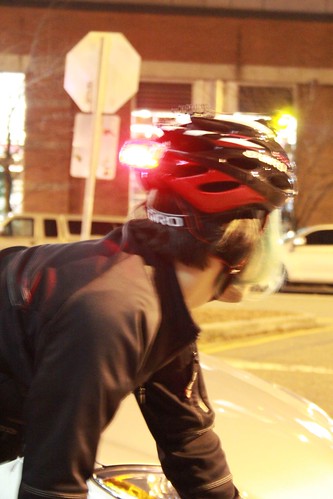Over the last ten years, lighting technology has improved dramatically. I remember ten years ago when I was delivering pizzas late at night, and I was burning through AA batteries on my mini-halogen light. So I invested in a big dual-beam headlight so I could be sure to have bright, consistent light till midnight and beyond. Nowadays, mini-halogen light have essentially vanished, and by comparison LED units can get much better performance out of the same AA batteries. Why would you want buy a light system anymore?
Well, it’s true that $30 buys you a much better light than it did a decade ago, but seeing and being seen should be pretty high on your priorities if you are riding your bike in these winter months of darkness. Over 60% of bike-car collisions happen after 4pm, when people are distracted from their driving and visibility is worse. It would be wise to take advantage of the newer generation of lighting to improve your safety rather than taking a barely-good-enough approach. Just as LED technology has improved replaceable cell battery powered lights, so too has it improved rechargeable light systems. But for light systems, it’s not just the LED but also the battery technologies as well as smarter circuitry to push performance even further. Lithium-ion batteries give more power, more consistently with more burn-time and less weight than lead-acid or Ni-metal.
Light & Motion designs, manufactures, and bench-tests some of the best commuter-targeted lighting systems right in Monterey, California. In an earlier review I tested their Seca800 system, which is a full-bore system meant to fill the needs of sporting cyclist/competitive athlete. Though I’ve sold a few Seca to commuters who have especially long and dark commute routes, the size, output, and price of the Commuter series will have broader appeal. It doesn’t hurt that all of the Commuter lights are USB rechargeable as well.
The Vis360 is helmet-mounted head and taillight combination. The battery is integrated into the rear light’s housing, and a slim coiled cable links to the diminutive headlight. The head and taillight have independent strap-mounts, and the straps’ simple security combined with a 130gr system weight mean that things stay put and pointed where you want them. The headlight produces a verified 110 lumens while the taillight kicks out 5 lumens of red LED. In addition, all the Commuter series systems include amber side lights to ward off the cardrivers’ right-turn hook, when a driver turns into you even though you are right beside them in the bike lane. You get 2-1/2hrs on high output, 5hrs on low, and 20hrs on flash. Many people like helmet-mount lights because they stay on your person if you fall off the bike, you can direct the light right at drivers with head movement, and you take don’t have to worry about the lights being stolen off your bike when you leave it locked up outside. At $169 retail, this is just a really smart package.
Also in the Commuter series are the Urban bar-mount headlights. Each of the 3 Urban lights is roughly the size of the very popular Planet Bike AA-powered light, the Blaze 1W, but the Urban lights house high-performance Li-on batteries inside their aluminium casings. The Urban’s rubber strap mounts securely fasten quicker and to a wide variety of tube shapes (for instance, to the wrapped portion of an FSA Wing Pro handlebar). The mount also allows the light to swivel in any direction, maximizing its mounting versatility. But what is really surprising is the amount of light these things pump out. Even the $100 Urban 180 (named for its 180 lumen output) is distinctly brighter, and the $130 Urban 300 is great. As the buyer for a LBS, I based my season program on stocking the 3 light systems I just described, and I left the Urban 500 off. I figured that $160 was too much to ask the consumer to pay for something smaller than a king-size Snickers. But then a customer special ordered one, and when it came in I just had to poke at the button because you can reach it without removing it from the packaging. Crikey! It was like setting off a light grenade in a box. When I thought about it, that little light was kicking out more light than my old halogen system that had a huge water bottle battery. I really like the beam distribution and long burn time of my own Seca800, but that little baby’s 500 lumens will flat out amaze you. And like the Vis360, the Urban lights have clever metering circuits to give different intensity settings so you can adjust output for different situations or to stretch out the burn time (example Urban500: 90min on high to 18hrs on flash). And don’t forget the amber sidelights.
Lastly there is the Vis180 taillight. Compared to the Planet Bike Superflash, the marketplace benchmark for AAA-battery lights, the Vis180 may not have the same intense cone of light, but overall it does produce more light over wider angle of 180deg, hence the Vis180’s name. What I like most about the Vis180 is its bright amber side lights, particularly since my Seca800 doesn’t have the sidelights of the Commuter series headlights. With a nod to training cyclists who ride in pace lines, the VIs180 has a setting utilizing only the sidelights, causing less visual annoyance and distraction to the rider behind you. At $100, it’s about 3 times more expensive than a Superflash, but when you factor in the cost of replacing batteries it looks more attractive. Realistically, a consumer interested in the build quality of an aluminium casing and unique lighting functions will find more in the Vis180 than someone who would rather prefer to fasten two or more Superflashes to the back of their bike (I have a number of customers like this). The reasons for buying the other Light & Motion Commuter series lights are more cut n’ dry: Vis360 provides a combination of performance and ergonomics that hasn’t existed before, and the Urban lights beat the pants off AA-battery lights.
Sidenote: the Vis180 has dainty, yet secure mount that allows you to adjust the vertical angle of the light with ease, but there’s a little trick to popping the light off the mount that isn’t quite intuitive. There’s a video on the L&M webpage for the Vis180 that conveniently demonstrates. Watch it once, then it’s easy. If you don’t wanna use the mount, the Vis180 will lock onto a clothing loop.
Yes, there are other light system manufacturers out there. But Light & Motion lab tests all their lights and post the results. An Urban 180 actually produces an honest 180 lumens, unlike a large portion of the industry. Frankly I initially chose Light & Motion just because their warrantee department was easy to deal with, which also is not an industry norm (I assure you). From an insider’s perspective, let me tell you if you sell enough that a certain percentage of electronics WILL have problems. That’s a fact. It’s just that for Light & Motion, the percentage is low and they get it done when they need to fix it. Maybe it has something to do with them doing it all in California rather than hawking some piece of foreign plastic with their brand stamped on it; I don’t know. I also don’t know how their prices can be competitive in day when typical thinking says that Chinese-made electronics are the only way to make a profit. And if the performance of the lights, unique safety features, bang for the buck, customer service, USB-charger convenience, and domestic manufacturing aren’t good enough for you, then maybe I should mention the awards that Light & Motion wins for their environmental practices.
So that’s about all L&M have to offer….if you’re shopping for compromise I guess you’ll have to look elsewhere.
Below can be seen the taillight portion of the Vis360, which also contains the battery.
…We're riding townies, adventure, and mountain bikes. Find recommendations on our store page. As Amazon Associates we earn from qualifying purchases.








